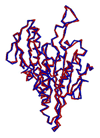 |
Core Grid Technology Group's roles in the project.
Core Grid Technology Group is responsible for creating newly Grid technologies
which should compose of the research infrastructure we aim to realize for biology.
To establish truly useful research infrastructure, Core Grid System Group is expected
to conduct R&D of Grid middleware based on the needs, wants, and demands of
researchers and scientists in the area of biology. |
 |
| 1. Computationics under the BioGrid environment |
| ♦Objectives |
 |
| kineshin models |
|
- Realize complete simulation of protein folding.
|
| ♦Issues in 2002 |
- Simulate protein folding structures on computers under the Grid environment.
This may allow protein structures to be analyzed in an environment similar to
in vivo.
- Identify the following year's challenges to gridificaton of computationics
applications.
|
| ♦Results from the project in 2002 |
- Successfully represent natural structures such as Kinesin and RAS by lattice
models.
- Successfully take samples of protein structure at all energy levels assuming
a simple interaction model (the Goh Model), describing protein-folding structures.
|
| ♦Future perspective and Goals |
| The results will be applied to the Grid Scheduling Systems. |
 |
|
| 2. Development
of a secure grid file system, GSI-SFS |
♦Objective
Realization of a user-friendly secure grid file system |
- Users' needs
1) Data sharing environment SDI (Single Disk Image)
2) On-demand Remote Filesystem Access
3) Data Confidentiality (encryption of network data)
4) Single Sign-on function (for achieving user-friendliness)
|
| ♦Outline of GSI-SFS |
| GSI-SFS is a user-friendly secure grid file system, in which the GSI (Grid
Security Infrastructure) and SFS (Self-Certifying File System) functions are integrated. |
- GSI (a component of grid security authentication infrastructure). Single Sign-on.
- SFS (a file system developed by Massachusetts Institute of Technology). Encryption
of communication channels. On-demand file system mounting.
|
| ♦Results from the project in 2002 |
| Release of Prototype GSI-SFS Version 1 development |
| ♦Future perspective and Goals |
- GSI-SFS will be installed into the BioGrid infrastructure system and the
results will be evaluated.
- Studies on SGI-SFS will be presented in academic papers and international
conferences.
|
|
| 3. Applying
the Grid to brain science: MEGrid project |
| ♦Objective |
 |
| MEG |
|
| The MEGrid project, which is a sub-project composing of Biogrid project, aims
at improving an infrastructure for future studies on brain science. It integrates
knowledge and technologies relevent to brain function analysis by the Grid, and
provides a virtual research environment. |
| ♦Results from the project in 2002 |
- Development of a visualization software with plug-in functionality to the
Grid
The visualization software visualizes the data obtained from a number of MEG (magnetoencephalography)
points and the result of Wavelet Cross-correlation Analysis. The software will
be seamlessly integrated into the Grid-enabled software allowing us to analyze
the brain function data with Wavelet Cross-correlation Analysis on the Grid.
- Development of MEGrid portal
Portal software has been developed to isolate the complicated mechanisms of the
Grid technologies from users. This facilitates scientists and researchers who
are engaged in the brain function analysis on the Grid environment to perform
efficient analysis.
|
| ♦Future perspective and Goals |
- Data-sharing environment will be established for analyzing the brain function.
- Visualization software and Portal software will be integrated on the Grid
environment.
|
|
| 4. Realization
of IPv6-based Globus Grid Toolkit: 6Grid project |
| ♦Objective |
- Provide a vast address space with IPv6 for establishing the Grid infrastructure
towards the coming global computing age.
- Create a secure Grid environment through the introduction of IP Security (IPSec).
|
| ♦Results from the project in 2002 |
- The 6Grid environment was established using IPv6-based Globus 1.3. Demonstration
tests were conducted in the IPv6 network connecting Kansai Office of the Japan
Atomic Energy Research Institute and Cybemedia Center. Demonstrations were made
at the Super Computing 2002 held
in Baltimore (USA).
- Version 6 of Globus 2.2.3 is currently at the final stage of development at
this time.
|
| ♦Future perspective and Goals |
- he studies will be presented at academic societies and in their journals.
- The integration of v6 code to the official version of Globus plans to be
explored.
- Collaboration with international research partners plans to be explored
- The results from the R&D activities will be evaluated in widely distributed
computing environment.
|
|
| 5. Improvement of infrastructure system: operation
and management of BioGrid Infrastructure System |
| Core Grid Technology Group promoted user-oriented and demonstration-based
researches. This achieved development of technologies that will produce fruitful
results in the future. |
| ♦Presentations of the research results |
|
|
|
 |
| In 2003, Core Grid Technology group will establish the cooperation with the
other groups: Computing Grid, Data Grid and Remote Data Collrection System, at
their developers' level to develop truly useful infrastructure technologies. |

